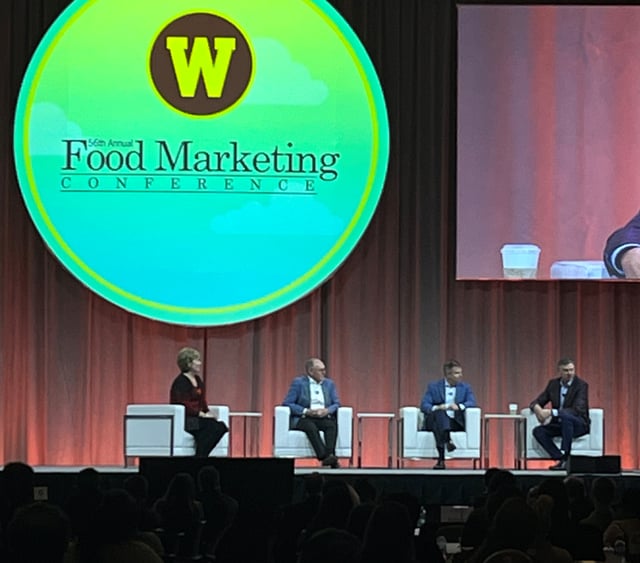Takeaways From 2022 Food Marketing Conference
Students from Western Michigan University’s Haworth School of Business who helped put on the 56th Annual Food Marketing Conference this week in Grand Rapids, Mich., weren’t the only pupils. As professionals across the grocery, CPG and technology sectors gathered in person on March 22 and 23 at the DeVos Place Convention Center, they took away fresh insights about today’s still-unusual state of doing business.
There were some common refrains from presenters representing different areas of the retail and CPG industries, reflecting key trends as organizations address challenges and look to future growth.
Opportunity Is Knocking, Loudly
Several speakers agreed that the pandemic accelerated trends that were starting to gain a foothold before 2020, notably in omnichannel retailing and technology. The almost-immediate embrace of e-commerce during the pandemic and the use of automation in the wake of labor shortages are leading to the swift implementation of platforms, services and technologies that moved from the long-term horizon to front and center.
Bryan Gildenberg, SVP, commerce, for Omnicom Retail Group, called it a “wet cement” moment: “For all of the problems of the world being in flux, don’t lose sight of the fact that all of this disruption creates the single biggest opportunity to change behavior as a retailer or a brand,” he said. “Do you remember saying, ‘I wish I could get shoppers to think about this differently’? This is all possible today.” He also noted that while e-commerce will comprise a portion of the business from here on out, brick and mortar stores globally are worth $21 trillion – roughly the same amount as the U.S. GDP. Even higher oil pries over the past few weeks present an opportunity for companies to start rethinking their reliance on petroleum-based plastics and make more strides towards the sustainability that they and their consumers say they want.
Shoppers Need Companions on Their Journey
However the balance of in-store and online shopping shifts, the ratio doesn’t matter as much as the ability to be a part of the equation. “You don’t get to choose where or how your shopper shops – you just need to be where they want to go,” advised Gildenberg.
Spencer Baird, EVP and president of the MarTech division at Inmar Intelligence, agreed. “We focus on sales, units and margins in a world that should care about shoppers, frequency and basket. The minute you flip over the planning process, in that it’s all about the shopper, it changes everything,” Baird remarked, adding that technologies are enabling grocers and retailers to get really, really close to their consumers via personalization at scale. “Can you imagine a world where you don’t have to pick one or two objectives a year, and can do an objective for every household? I think we are right on that doorstep.”
Technologies Are Converging – Fast and to the Benefit of Food Providers
As food marketers get more familiar with things like artificial intelligence (AI) and robotics, capabilities are leapfrogging ahead. “I’m convinced that the tech is so far ahead of humans,” said Baird, adding, “The world that’s coming is available today.”
Brian Sathianathan, co-founder, chief technology officer and chief digital officer for Iterate.ai, used his keynote address to outline converging and maturing advances in AI, 5G, the internet of things and augmented reality that will make next year a crucial pivot point. “The digital-first economy will be half of the economy by 2023,” he declared, noting that, “Every one of your products could have 'brains' or memories.”
Meanwhile, PepsiCo's John Phillips (a WMU alum) pointed out that building resiliency and automation into operations will propel organizations to future growth, by taking advantage of systems that alleviate labor and supply chain issues. He cited technologies like automated systems that can unload trailers without the need for forklift drivers and automated 24-hour click-and-collect sites. “All of the building blocks are there to build a fully automated grocery distribution. This isn’t ‘Star Wars’ stuff – it exists today,” said Phillips, SVP, customer supply chain and global go-to-market.
Investment in Human Capital Pays Off
One of the resounding themes of this year’s Food Marketing Conference was the importance of people, from retail employees to customers to community members and global residents in need. While people have long been a part of the classic “5 P’s of Marketing,” the pandemic and simultaneous focus on corporate responsibility and ESG principles have amplified the need for personal connections, evident in actions like higher employee wages and bonuses, greater workplace flexibility and expanded community donations and support. All three CEOs who participated in an executive panel discussion moderated by FMI's president and CEO Leslie Sarasin – Rick Keyes of Meijer, Jim Snee of Hormel Foods and Brandon Barnholt of KeHe Distributors – shared their gratitude for employees who never stopped working during the pandemic and agreed that companies play an important role in supporting workers’ mental health and wellness as well as their physical well-being.
The CEO of SpartanNash, Tony Sarsam, chose to talk about his company’s “People First” culture in the event’s closing keynote address, declaring, “All great performances come down to thinking about people first.”






